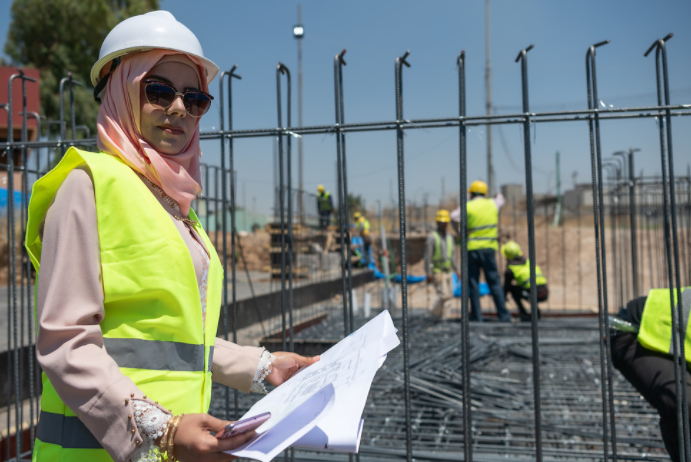Speeches Shim

As the largest donor of the 28-donor program, USAID is supporting international efforts to stabilize areas recently liberated from ISIS by restoring damaged or destroyed essential services and providing the conditions for a safe and voluntary return of IDPs to their home.
Project Snapshot
- Implementing Partner: United Nations Development Programme (UNDP)
- Project Duration: July 2015 – December 2023
- Locations: Anbar, Ninewa, and Salah al-Din (other donors also found in Diyala and Kirkuk)
- Budget: $500,000,000
- Contact: Jodi Rosenstein, Jrosenstein@usaid.gov
Context
With their arrival in northern Iraq in 2014, the violent and inhumane tactics of the so-called Islamic State of Iraq and Syria (ISIS) resulted in mass extinctions and forced displacement of religious and ethnic minority groups, and gross, systematic abuses of human rights, including rape and other forms of sexual violence. In response to these atrocities, the Global Coalition to Defeat ISIS was formed in September 2014, which brought together 82 members committed to tackling ISIS on all fronts.
Over 6 million Iraqis initially fled from their homes to camps for internally displaced persons (IDPs) across Iraq. In retreat, ISIS systematically destroyed public infrastructure in the occupied areas of Iraq, and many areas were sites of catastrophic liberation battles. Many IDPs’ homes were destroyed, with no electricity, water, schools, or health services. As of November 2020, over 1.28 million Iraqis remain displaced, with many of the areas occupied longest by ISIS still facing immense destruction and lack of basic services.
USAID Response
In support of the Global Coalition to Defeat ISIS and in partnership with the Government of Iraq, the Funding Facility for Stabilization (FFS) is a 28-donor, multilateral program that aims to stabilize areas recently liberated from ISIS by restoring damaged or destroyed essential services and providing the conditions for a safe and voluntary return of IDPs to their home. USAID is the largest donor of this program. FFS rehabilitates critical public infrastructure, such as water, electricity, schools, housing, and health facilities. The program also supports livelihoods through cash for work activities and, through other donors, small business grants, as well as discreet social cohesion programs to facilitate safe and sustainable returns.
Achievements to Date
- Rehabilitation efforts: USAID has rehabilitated 130 schools, 57 primary health care clinics, 62 water treatment plants, and 17 substations.
- Restoration of critical hospital care: USAID rehabilitated three (3) hospitals in Tikrit, Qayyara, and Hamdaniya. Tikrit Teaching Hospital, which was used during ISIS occupation as a bomb factory, now serves over 1.5 million people. In Qayyara, Qayyara General Hospital opened only four months before ISIS occupied the town. During the occupation of Qayyara, ISIS ran and managed the entire hospital. As militants fled the hospital during liberation efforts, they caused severe damage to the hospital by filling one of the elevators with explosives and detonating it. Through USAID, the American people supported the rebuilding of Qayyara General Hospital, which reopened in November 2019 and once again provides critical healthcare services to a population of 200,000 people. Collectively, the USAID-rehabilitated hospitals in Hamdaniya, Tikrit, and Qayyara serve a population of approximately 2.1 million people.
- Water in western Anbar: USAID has helped to provide residents of remote western Anbar – one of the driest regions in Iraq – with a reliable water supply. Access to water during ISIS occupation was limited, with the local population having only a couple of hours of running water during the day, every few days, making day-to-day life extremely difficult. By rehabilitating water treatment plants and distribution networks across western Anbar, USAID has helped provide approximately 1.38 million Anbaris with reliable access to safe and clean water.
- Promoting youth education: ISIS’s occupation forced many schools across Iraq to close. Some students had no option but to discontinue their studies. Others had a chance to establish makeshift classrooms, usually in a neighbor’s home. The schools that remained open had no choice but to scrap their curriculum and adopt ISIS-approved materials. By rehabilitating 130 schools since Iraq’s liberation from ISIS, USAID has helped boys and girls of all ages return to the classroom.
- COVID-19 response: In 2020, USAID funded COVID-19 isolation rooms and related equipment in nine (9) provinces and began the rehabilitation of the East Mosul Medical Fluids Factory in Ninewa. In October 2020, the first of nine USAID-funded COVID-19 isolation wards opened in Dohuk, a region where cases of COVID-19 continue to rise and local health facilities struggle to respond. By the end of 2020, COVID-19 isolation wards will be completed in Babil, Dhi Qar, Dohuk, Karbala, Kirkuk, Maysan, Najaf, and Ninewa, serving a total of nearly 10 million Iraqis.

Comment
Make a general inquiry or suggest an improvement.